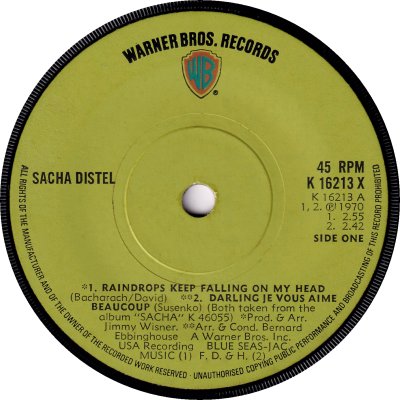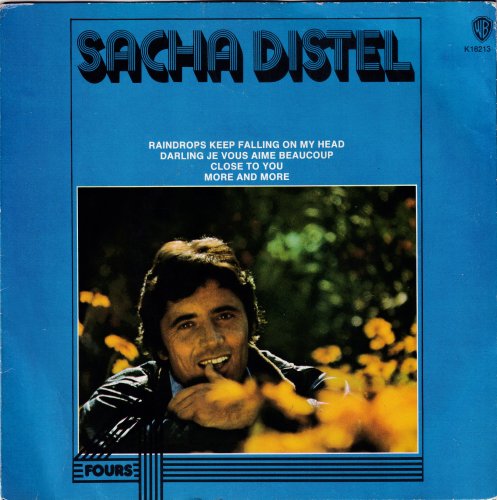








































American, out of Burbank, California; at first the record arm of Warner Bros. film studio. The Warner Bros. label first saw the light of day in 1958; its president was James B. Conklin. It made a slow start, for a company with its parent's rich backing to draw upon, but it made a major - and costly - signing in 1960, when it added the Everly Brothers to its roster. Peter, Paul and Mary provided a boost to the label's chart fortunes when they joined it in 1962; the company's hit potential increased when, in 1963, it purchased Frank Sinatra's 'Reprise' label. Warner Bros. was sold to Seven Arts in 1967; the new company, Warner-Seven Arts, bought Atlantic Records that same year, and the two labels operated side by side autonomously. Another deal followed in 1969, when Steve Ross's Kinney Corporation acquired Warner-Seven Arts, including its record labels. Ross persuaded the labels' management teams to stay on board with a firm promise of no executive interference, and he appears to have honoured his word. That same year Warner Bros. set up a prototype distribution arm in Southern California. It proved successful, and Jac Holzman of Elektra broached the idea of a mutual distribution pact between his label and those of the Kinney Corporation. In order for the pact to be feasible Elektra had to come under the Kinney umbrella; talks between Holzman and Ross saw the latter purchase Elektra in June 1970. As was the case with Atlantic and Warner Bros., Elektra functioned autonomously within the group, working with the others but keeping its individual identity and operating as it had done when it was an independent. The distribution network was expanded, and Kinney took the first steps in establishing an international network; it set up its first branch in London. Ross inaugurated Warner Communications in 1971, and Kinney Record Distribution became the WEA Corporation ('Billboard', 31st August 1996). Kinney's International division had its name changed to WEA Music International, and the company's overseas subsidiaries underwent a similar name-change over the next few months ('Billboard', 11th March 1972). WEA's various components prospered, and the '70s saw Warner Bros. growing to be one of the world's major record labels, a position it holds to this day.
In Britain the Warner Bros. label came on the scene in 1960, via a licensing agreement with Decca; it switched to Pye in 1965, again under a licensing deal. Following the acquisition by Seven Arts 'Record Retailer' of the 13th of February 1969 revealed that Warner / Seven Arts / Reprise was planning to go independent in September of that year; 'RR' of the 25th of June reported that the move would take place on the 4th of July and would be a low-key affair. After the takeover by Kinney 'RR' of the 24th of January 1970 said that Warner-Seven Arts was to be known as Warner Brothers Records and that the company was to start using its old logo and shield again. 'RR' of the 27th of June added that the intention was for Warner-Reprise to do its own marketing when the licensing deal with Pye expired, which it was due to do the following year. According to 'RR' of the 14th of November the intention was to bring Warner Bros., Atlantic, Reprise and Elektra together eventually, but the union would not be able to take place until the various current agreements had run their course. Warner Brothers Records made a £6m bid for Island in August 1970 ('RR', 29th August), but it was turned down; there were talks about the two of them forming a joint distribution company but these also came to nothing ('RR', 23rd January 1971). Warner / Kinney looked elsewhere for a partner, and 'RR' of the 20th of March 1971 was able to break the news that the search had been successful: Kinney and CBS had agreed to set up a joint pressing and distribution operation from the 1st of July, at the end of Warner's agreement with Pye, in a deal lasting for three years. Atlantic's licensing deal with Polydor ended at the start of January 1972, leaving that label free to join its siblings at CBS / Kinney; it was relaunched in March of that year. Kinney underwent a corporate name-change from the 1st of July, becoming WEA; likewise CBS / Kinney became CBS / WEA.
Despite the fact that a lot of effort had been put into bringing Warner-Reprise, Atlantic and Elektra together in the UK, they were destined not to stay that way for very long. WEA's British arm initially had a 'label co-ordinator' to give the various labels individual identities within the group ('Music Week', 14th October 1972), but 'MW' of the 17th of March 1973 reported that there were plans to create separate identities for the three companies and that each was to have its own press officer. Three months later 'MW' of the 23rd of June broke the news that WEA in the UK was to be split into four autonomous companies; each was to have its own office and was to report directly to the parent company in the USA. WEA itself was to function solely as a sales and distribution company servicing the three main labels, Warner-Reprise, Atlantic and Elektra. The split was reported to have been at the behest of WEA in America, and the idea was that the heads of the labels in that country would be able to make their own decisions about the UK talent that their labels handled. The split was too much for WEA's managing director in the UK, Ian Ralfini: 'MW' of the 14th of July carried the news that he had resigned, and it attributed his departure mainly to the break-up. Managers were recruited for the various components, and the move went ahead. David Geffen, of Asylum Records, was made the new head of Elektra; in September 1973 he took that label to EMI in order to unite it with Asylum. The united Elektra-Asylum eventually came back to the WEA fold on the 1st of February 1976, under Geffen's successor, Joe Smith ('MW', 17th January 1976).
WEA was an ambitious company, and 'MW' of the 19th of June 1976 reported that the company planned to open its own distribution facility in the summer of the following year. A new facility was duly set up at Alperton; it was scheduled to begin servicing 500 major accounts on the 4th of April 1977, with the rest following by June ('MW', 2nd April). Not content with handling its own distribution, it acquired a majority shareholding in Damont, a custom pressing and budget record company; the current pressing deal with CBS was unaffected ('MW', 9th July 1977). Then in December 1977 it bought Island's manufacturing plant in West Drayton. At that point the contract with CBS still had sixteen months to run, but the plant, which was to be expanded, could be used to service third-party customers and to handle WEA's own overflow work ('MW', 24th December 1977). WEA may have come to an agreement to start pressing its own records a little earlier than the contract allowed; the few of the company's singles from early 1979 that I have seen in the vinyl have been from its own plant rather than that of CBS. The only other major event of the decade was the introduction of British WEA's own label, WEA (q.v.), in 1978.
Warner Bros. records boasted a variety of label designs. The first one, which was red in colour, came on the scene in 1960, at which point the singles were manufactured and distributed by Decca. Initially the placing of the prohibitions gave the label a rather cluttered appearance (1), but they were soon made less invasive (2). Stereo EPs had their own special gold label (13). Catalogue numbers of Warner Bros. singles started at WB-1 and reached 162 during the Decca years. Mono EPs had WEP-6000 numbers; for stereo ones the prefix became 'WSEP'. The move to Pye, in May 1965, was accompanied by a change to a new, orange, label (3), which lasted until February 1971; at that point a somewhat plainer-looking green label appeared (4). The green label had its layout altered in June 1971, with the artist's name moving from 6 o'clock to 9 o'clock. The switch to Pye also saw a change of numbering, which became rather complicated. Singles which had American counterparts - records with the same 'A' and 'B' sides - kept their original American numbers but with a 'WB' prefix; thus the American 5628 became WB-5628 here. That applied to records in the 5600s and the 5800s up to 5900. From 5900 the numbers jumped to the 7000s, but for some reason the American 7020 and 7028 became 7520 and 7528 here. After that the numbers remained parallel from 7056 through the 7100s, 7200s, 7300s and 7400s. There were several other series: the WB-5700s and later the WB-6000s were for singles whose sides either didn't appear in the USA or else appeared there in different combinations, while singles in a WB-2000 series had the same numbers as their American equivalents on the Loma label - thus Loma 2054 was issued here as WB-2054. After the takeover by Kinney, starting in January 1970, a WB-8000 series appeared; this seems to have been reserved for material which originated outside America, primarily from the UK.
With the setting up of the joint CBS / Kinney operation, in July 1971, Kinney adopted a K prefix and five-figure numbers for all its products apart from those on Rolling Stones Records (q.v.), whose singles had the five-figure number but an 'RS' prefix. Warner Bros. singles were numbered in the K-16000s. This numerical series lasted for the rest of the decade, though in time it evolved into the 17000s. The green label (5) survived the transition and stayed in place until May 1973, when it was replaced by one showing a tree-lined boulevard (6). This lasted until August 1978, though in March and April 1976 a handful of singles appeared with a red label featuring a picture of Brighton Pier (8). Managing director Derek Taylor was quoted in 'MW' of the 20th of March as saying that the 'Boulevard' label was "too Americanized for this country"; the article said that, on singles, it was to be replaced by the 'Brighton Pier' one, which had been designed by David Costa - albums would keep the 'Boulevard' type. The change proved short-lived. 'MW' of the 17th of July reported Taylor as saying that the 'Brighton Pier' design had been "dropped temporarily" as the image hadn't been copyrighted by the company at the time when it was first brought into use. The article went on to say the initial pressings of the Bellamy Brothers' 'Let Your Love Flow' (K-16690; 4/76) were the last of ten singles to carry the design. In the event, the 'temporary' dropping became permanent, and for some reason the 'Brighton Pier' design failed to reappear. The 'Boulevard' was phased out in September 1978, and a fawn-coloured label was introduced; this lasted for the remainder of the decade (10). There were minor alterations along the way: a hollow 'A' appeared on the labels from September 1974 (7); from July the following year the perimeter text changed to include a reference to the Warner Communications Company and the company's logo (9); and the position of the artist and title credits changed. The occasional injection-moulded label can be found (11); these are the results of contract pressings of popular singles - Phonodisc was responsible for the example shown.
With regard to promo copies: Decca-era ones initially were single sided. The first two had plain plum-coloured labels (14) but with the third release they turned lilac and gained the trademark arrows (15). As was the case with the other Decca family promos, they came in plain brown sleeves (40). By November of that first year (1960) they were double sided; the labels were now similar to those of issues but they had white tops and bottoms (16). In August 1962 a large hollow grey 'A' was added to the appropriate side (17). The grey 'A' shrank, filled-in, turned light green and moved to one o'clock (18) in or around October 1964; the final few Decca promos were issue labels overprinted appropriately - these overprinted labels had made occasional appearances earlier (19). Pye-era demos followed the Pye family pattern. They were white at first, with the label name in bold print at the top and a solid 'A' in the centre (20); in April 1967 the colour turned yellow, and the 'A' grew in size and hollowed out (21) - thanks to Nicholas Hough for that scan, which has been doctored to replace a missing centre. From November 1967 the large name was replaced by a smaller one and the company's logo was added (22); this design lasted until March 1970, when it was replaced by a yellow version of the issue label, overprinted in red with the appropriate text and a large hollow 'A' (23) - the yellow colour of this design turned white in October 1970 (24). The practise of using overprinted white versions of the issue label continued after the arrival of the green label in February 1971 and was retained into the CBS / Kinney days (25). The white labels stayed in place after the introduction of the 'Boulevard' design for issues, though in November 1973 the 'Advance promotion copy' text disappeared and the 'A' got thinner and taller (26). After August 1974 designated promo labels seem to have been discontinued; they returned on selected singles in late 1978, after a fashion, in the form of issue labels with the appropriate wording added (27).
Finally, we turn to the various company sleeves that were used. The Decca-era ones had arrow-heads around the label, pointing in towards it. For the first couple of dozen issues or so the sleeves were brown (28), but they turned grey before 1960 was out (29). When Warner Bros. switched from Decca to Pye, in 1965, a white sleeve with stylized pink arrowheads was adopted (30). In the Summer of 1968 this design was replaced by a greenish one with a Warner-Seven Arts logo (31), which seems to have lasted for a few months into the new decade; by July 1970 the references to Pye and Warner Bros-Seven Arts Records at the bottom were in different fonts, and they had swapped places (32). At the time of the move from Pye to Kinney, in 1971, the Warner-Seven Arts logo was replaced by a Warner Bros 'Shield' one (33). The shield remained in place until the autumn of 1978, though its design and colour altered during that period; the basic colour of the sleeve changed too, from green to a sort of fawn-yellow (34, 35). With the introduction of the fawn label, singles on the various WEA labels began to be housed in an all-purpose multicoloured company sleeve (36), which later lost some of its colorfulness (37). At some point in 1979 the all-purpose sleeve turned brown and changed design (38). In October 1972 a 'Fours' series of EPs were given picture covers (39); they had an 'X' added to the end of the catalogue numbers but there was nothing on their labels to distinguish them (12). A 'Warner Giants' series of EPs from 1974, consisting of K-16405 to K-16412 together with several titles on Reprise, had its own particular sleeve (40) but no distinguishing marks on the labels. I have put together a discography of Warner Bros. singles for the 1970s; it is on the large side, so I have given it its own page, here.
('Both Sides Now'; www.bsnpubs.com)


Copyright 2006 Robert Lyons.

